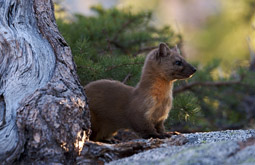American Pine Marten
The American pine marten is a predator that belongs to the family of martens (Mustelidae). Its habitat spreads from Newfoundland and Novia Scotia in the East to Alaska in the West, all the way to California. Because it is hunted intensely and due to the destruction of its habitat, numbers have decreased significantly – although the American pine marten is not considered to be an endangered species.
The American pine marten strongly resembles our domestic pine marten. It is long and slim and has large eyes, „cats’ ears“, and long, bent claws. Its long and shiny fur is grey in the head area, dark brown or black around the legs and the tail, and pale brown on the back. It has a light spot on its chest. Males reach a head to trunk length of 36 to 45 cm and have tails that are 15 to 23 cm long. A grown male weighs between 1,0 and 1,5 kg. Females are one third smaller. Pine martens can live for up to 9 years.
As typical forest dwellers, pine martens prefer dense coniferous forests where they find shelter in hollow trees, crevices, and dens abandoned by other animals. A large part of the life of pine martens takes place in trees. Thanks to their sinuous bodies and long, strong claws, pine martens are agile climbers. Pine martens leave their odor marks on trees to mark their territory. Their territories vary tremendously depending on the habitat and the quantities of food available. Pine martens feel at ease on the shores of water and in water. They do not hibernate in winter and remain active throughout the year. It is very difficult to observe these shy forest dwellers in their natural habitat.
The American pine marten is highly flexible with regard to its nutrition. It feeds mainly on small rodents and squirrels and sometimes also birds, birds’ eggs, nestlings, berries, and fruit. Pine martens kill their prey with precise neck bites. Martens chase their preferred prey, squirrels, through the trees. They are primarily active at night but sometimes also chase during the day, if prey is available.
Pine martens are loners and rogues and only friendly with one another during mating season, from June to August. Males and females find each other by following odor marks. After mating in the summer, the fertilized egg cells remain in a state of latency and only nest into the uterine lining between the end of January and mid-February. The female will then litter (1 to 5 young per litter) between the end of March and the beginning of April. She will suckle her young for approx. 42 days, which is a sufficient time period for them to reach their full size. Pine martens are sexually mature at 15 to 24 months of age.


